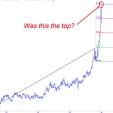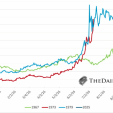Market Turning Points
Current position of the market
SPX: Very Long-term trend – The very-long-term cycles are in their down phases, and if they make their lows when expected, there will be another steep decline into late 2014. However, the Fed policy of keeping interest rates low has severely curtailed the full downward pressure potential of the 40-yr and 120-yr cycles.
Intermediate trend – May be tracing out an ending diagonal pattern.
Analysis of the short-term trend is done on a daily basis with the help of hourly charts. It is an important adjunct to the analysis of daily and weekly charts which discusses the course of longer market trends.
AT A CYCLE CLUSTER TOP
Market Overview
There are some important technical considerations to consider at this juncture! The first is that the market has reached a time frame when four important cycles are topping simultaneously. (They will be detailed a little later on.) This is most likely the reason why the SPX has risen into this short-term top with so much strength. The conservative projection for a short-term top was 1930. It was validated by a quick 8-point decline after that price was reached, but it bounced right back up, immediately making a new high and finishing nearly 20 points higher on Friday. Bottoming cycles usually produce well-defined low points in the market but cycle tops tend to be more rounded. For that reason, we may experience a period of distribution in this area before starting a significant decline -- unless, of course, last week’s move was an overthrow outside of an ending triangle! In which case, a sharp decline could be just ahead.
Looking at more conservative alternatives, we should also acknowledge that the structure does not appear to be complete. Friday’s close may only represent a third wave which has just a little more to go before wave 4 starts; this could be accomplished in the first couple of hours of trading, and after wave 4, we would need to finish wave 5 (from 1868). If this scenario is correct, the cycles will not cause prices to retrace immediately.
Before making a specific forecast, let’s see how this plays out. Last week showed that there is still plenty of (genuine?) strength in this market and that the bulls are still in control. But what about our leading indexes, IWM and XBD? They both rallied but remain well below their March top. XLF eked out a slightly higher high, but this has not erased its relative weakness to the SPX. DJIA also traded a little higher in what could be an overthrow above the top trend line of its ending triangle pattern.
In summary, last week’s action still leaves us with a disjointed set of indexes which make up the total market and we should look forward to next week’s trading to bring about a little more clarity.
Chart Analysis
We’ll start by looking at the weekly SPX chart (courtesy of QCharts.com, as are all the other charts in this section). We are looking at the price channel from 2012 and, during the first year, the index hugged the bottom trend line, but then started pulling away, forming an inner channel that just kept on rising all the way to the top of the main one. A couple of months ago, it looked as if the trend was beginning to decelerate but in the past four weeks, the momentum picked up again and continued to accelerate until last Friday.
It’s an impressively bullish chart; but is this a last hurrah with SPX now needing a rest? As you can see, there are 4 cycles topping in this region (6-wk, 10-wk, 22-wk and 30-wk). The 40-wk cycle already peaked on May 2, so make that 5. We cannot take cycles for granted. Therefore we need to see how this topping cluster will affect the market.
As for the oscillators, the SRSI has reached the top of its range, is now overbought, and could start retracing at any time. The MACD is slightly negative, with some divergence showing, but it is still in an uptrend. If it turns down anytime soon, it will signal a problem for the market.
The daily chart also reflects the late burst of strength which caused the index to overcome not only the extension of a former bottom channel line which had contained prices since late April, but also drove the index through the line connecting former tops. Undoubtedly, massive short covering assisted in these feats, so we’ll see what happens over the next few days. If SPX retraces below the top trend line, it may not be as strong as it appears and the conservative structure presented above may have to be revised. Having reached the top of the green channel as well as that of the steep narrow channel, resistance should be expected which could stop the rally in its tracks and cause a reversal.
Whether or not this is an overthrow through the top of a wedge pattern remains to be seen. The indicator to watch for confirmation is the lowest one, the A/D oscillator. Its tops have been in a declining trend since mid-February. The odds are pretty good that a minor correction, at least, will start very early next week (perhaps even early Monday). If that indicator shows much weakness on its next retracement, it will raise some legitimate questions about the market’s strength. The SRSI has been overbought for two weeks and is long overdue for a correction and, in spite of its recent rise the MACD is still showing some mild negative divergence. Those are not strongly positive readings so what happens next to the technical aspect of the market should be watched carefully
Finally, it won’t hurt us to analyze the hourly chart to see what the near-term picture looks like.
Actually, the chart and its indicators are in a weak technical position. As it aproaches the top of the green channel, the index shows price deceleration vis a vis the blue channel. This is normally a warning that precedes the breaking of a trend line.
With the two lower oscillators overbought, and some divergence showing in the price MACD, a test of that trend line may be just around the corner. Already, and in spite of Friday’s strength, all three oscillators are beginning to roll over. If, in the process of correcting, the MACD were to break below its former low, it would be a sign of weakness, especially if it goes negative. Since technically we are still in a neutral but vulnerable state, let’s see what develops over the next couple of days.
Cycles
We can count 4 cycles ranging from 4 weeks to 30 weeks in length that are topping in this time period. The way the market responds to this potential negative will reveal how legitimate was the strength recently displayed, particularly as the shortest cycles make their lows over the next couple of weeks.
One of these cycles is the 22-week cycle. This is a cycle that has exerted a lot of control over the market in the past, although it has gone through some periods of inconsistency. If it is starting to re-assert itself, it could have a negative effect over the market between now and the end of the month.
Breadth
The McClellan Oscillator and the Summation Index appear below (courtesy of StockCharts.com).
Some improvement in the A/D has turned the NYMO back up, but it still remains at a fairly low level and does not support the acceleration of the uptrend in price. Consequently, it did not have much impact on the NYSI.
Both indicators are actually showing increasing negative divergence to the price level. If the market corrects, this will become even more obvious.
 Sentiment Indicators
Sentiment Indicators
The SentimenTrader (courtesy of same) long term indicator has jumped a notch to 70. This is the level which brought about the January correction, although it did remain at that level for several weeks. Nevertheless, this does mark an increased state of negativity for the market and it should not be dismissed lightly.







All of the following charts are courtesy of QCharts.com
VIX (CBOE volatility Index)
Las week, VIX made its lowest low since January 2007 -- even before the last bear market started. I am not sure if this has any immediate significance for the current bull market. Perhaps it means that we are nowhere near a high since VIX started rising months before the start of the bear market.
XLF (Financial ETF)
XLF has made a fractional new high, but it does retain its relative weakness to SPX. Like all indices, as long as it remains above its 200-DMA, it remains in an uptrend.
TLT (20+yr Treasury Bond Fund)
TLT has pulled back slightly after failing to make a clean break above its long-term downtrend line. It does not look very serious at this time -- especially since it remains above its 200-DMA.
GLD (ETF for gold)
GLD rose up to its 200-DMA when its cycle turned up, then turned down again in the cycle’s down phase. The 25-wk low is scheduled for mid to late June and, if GLD manages to remain above its previous cycle low, it should have a good chance at overcoming both the MA and the top channel line.
UUP (dollar ETF)
If the dollar is affected by the same cycle as gold – but in reverse – it should continue in a basic uptrend for another couple of weeks before starting to retrace its move. That should prevent it from coming out of its down channel...and then what? New lows?
USO (US Oil Fund)
USO is not making a very bullish pattern. For the third time it has been stopped by the mid-channel line while making a wedge formation. This strongly suggests that the next easiest path for prices will be down!
Summary
Every week, it seems that new contradictory factors appear which prevents us from making a definite statement about the viability of the market trend. On the surface, there is no question that we are in an uninterrupted uptrend which shows no sign of an immediate reversal unless, that is, we just witnessed a terminal move outside of an ending triangle in both the DJIA and the S&P. That, of course, remains to be seen and will have to be confirmed by the market itself. Was last week’s burst of strength genuine?
Here are some factors which are causing me to withhold judgment: 1) leading indicators (IWM, XBD and, to some extent, XLF) are still lagging; 2) we are in a time zone where several important cycles are topping simultaneously which was perhaps the cause of this show of strength (with the assistance of heavy short-covering?); 3) while the A/D line made a new high, the McClellan Oscillator and other breadth oscillators have not really confirmed this degree of strength in price; 4) The SentimenTrader long-term indicator increased to a bearish 70; 5) VIX declined to its lowest level since January of 2007!
Based on these observations, I reserve judgment about the market’s ability to continue to rise no serious correction in sight!
********
FREE TRIAL SUBSCRIPTON
Market Turning Points is an uncommonly dependable, reasonably priced service providing intra-day market updates, a daily Market Summary, and detailed weekend reports. It is ideally suited to traders, but it can also be valuable to investors since highly accurate longer-term price projections are provided using Point & Figure analysis. Best-time reversal estimates are obtained from cycle analysis.
For a FREE 4-week trial, send an email to: info@marketurningpoints.com
For further subscription options, payment plans, weekly newsletters, and for general information, I encourage you to visit my website at www.marketurningpoints.com. By clicking on “Free Newsletter” you can get a preview of the latest newsletter which is normally posted on Sunday afternoon (unless it happens to be a 3-day weekend in which case it could be posted on Monday).
The above comments and those made in the daily updates and the Market Summary about the financial markets are based purely on what I consider to be sound technical analysis principles. They represent my own opinion and are not meant to be construed as trading or investment advice, but are offered as an analytical point of view which might be of interest to those who follow stock market cycles and technical analysis.


















